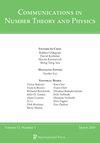具有小中心电荷的极值CFTs的性质
IF 1.2
3区 数学
Q1 MATHEMATICS
引用次数: 6
摘要
利用$c\leq 24$分析了现有二维极值手性(超)共形场理论的几个方面。在这些理论中,维度小于或等于$c/24$的算子只有真空及其(超级)维拉索罗后代。典型的例子是巨形CFT,其著名的属零性质与其缠绕配分函数的Rademacher可和性密切相关,这一性质也区分了Mathieu函数和umbral moonshine函数。然而,现在有几个额外的已知极端cft的例子,它们都至少有$\mathcal N=1$超对称和整体对称群连接到零星的简单群。我们研究了这种将月光模与其他$c=24$手性cft区分开来的性质在多大程度上适用于其他已知的极端理论。我们发现,在大多数情况下,除了Conway模和具有$M_{11}$和$M_{22}$对称性的$c=12, ~\mathcal N=4$超共形理论外,对于其他极值cft不存在特殊的Rademacher可和性。这表明极端CFT、偶发群和模拟模形式之间的联系超越了严格的Rademacher可和性标准。本文章由计算机程序翻译,如有差异,请以英文原文为准。
Properties of extremal CFTs with small central charge
We analyze aspects of extant examples of 2d extremal chiral (super)conformal field theories with $c\leq 24$. These are theories whose only operators with dimension smaller or equal to $c/24$ are the vacuum and its (super)Virasoro descendents. The prototypical example is the monster CFT, whose famous genus zero property is intimately tied to the Rademacher summability of its twined partition functions, a property which also distinguishes the functions of Mathieu and umbral moonshine. However, there are now several additional known examples of extremal CFTs, all of which have at least $\mathcal N=1$ supersymmetry and global symmetry groups connected to sporadic simple groups. We investigate the extent to which such a property, which distinguishes the monster moonshine module from other $c=24$ chiral CFTs, holds for the other known extremal theories. We find that in most cases, the special Rademacher summability property present for monstrous and umbral moonshine does not hold for the other extremal CFTs, with the exception of the Conway module and two $c=12, ~\mathcal N=4$ superconformal theories with $M_{11}$ and $M_{22}$ symmetry. This suggests that the connection between extremal CFT, sporadic groups, and mock modular forms transcends strict Rademacher summability criteria.
求助全文
通过发布文献求助,成功后即可免费获取论文全文。
去求助
来源期刊

Communications in Number Theory and Physics
MATHEMATICS, APPLIED-MATHEMATICS
CiteScore
2.70
自引率
5.30%
发文量
8
审稿时长
>12 weeks
期刊介绍:
Focused on the applications of number theory in the broadest sense to theoretical physics. Offers a forum for communication among researchers in number theory and theoretical physics by publishing primarily research, review, and expository articles regarding the relationship and dynamics between the two fields.
 求助内容:
求助内容: 应助结果提醒方式:
应助结果提醒方式:


